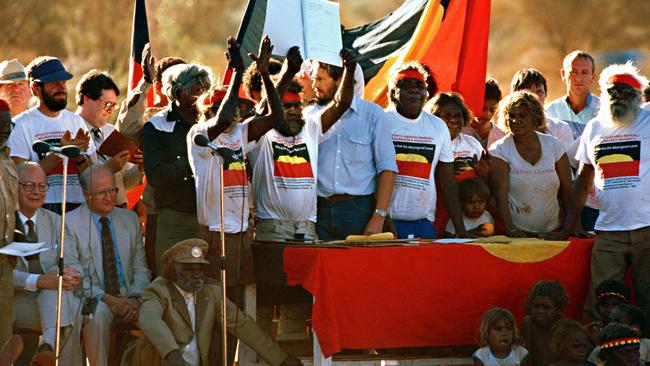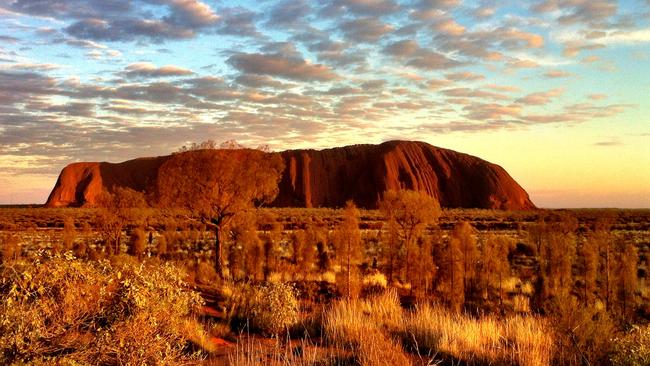Uluru handover finally restored sacred rock to Anangu people
Ownership of the central Australian landmark Uluru was returned to Aboriginal people in a ceremony at the rock 30 years ago today.

Today in History
Don't miss out on the headlines from Today in History. Followed categories will be added to My News.
“Uluru, I ... wanted to take away some of your magic with me for the rest of my travels, for the rest of my life even,” a French tourist wrote to park rangers last year. “I realise it was wrong, therefore I am sending both pieces back to you.”
The letter, with 220g of rock, is among thousands regularly received from awe-struck visitors left remorseful and even haunted by souvenirs stolen from an ancient Anangu Aboriginal sacred site.
Described as “certainly the most wonderful natural feature I have ever seen” by explorer William Gosse, the first European to climb to the summit with Afghan Kamran in July 1873, ownership of the central Australian landmark was returned to Aboriginal people 30 years ago today.

The handover by then governor-general Sir Ninian Stephen at the base of the rock on October 26, 1985, ended almost a decade of heated debate over ownership of Ayers Rock and Mt Olga.
English-born William Ernest Giles was the first European to explore Central Australian deserts when he led an 1872 expedition that sighted the rock from Mt Olga, named for Queen Olga of Wurttemburg at the request of Giles’ benefactor, German-born Victorian botanist Ferdinand von Mueller. Olga’s husband King Charles had named Mueller as a baron the year before.
Commissioned by the South Australian government to lead an expedition to discover a route to Perth, Gosse climbed the rock after a three-month trek from Alice Springs. His expedition included another four Europeans, an Aboriginal boy, three Afghan cameleers and a camel train to carry eight months of provisions. They camped two nights at Ayers Rock during a four-month expedition.
To his “astonishment”, Gosse noted his discovery “was one immense rock rising abruptly from the plain; the holes I had noticed were caused by water in some places forming immense caves”, where he discovered ashes from Aboriginal camp fires.
Recorded as the world’s largest monolith, the sandstone rock was formed more than 600 million years ago. Aborigines have lived in the area for up to 30,000 years.
The rock is 348m high, about 3.6km long, 1.9km wide, with a circumference of 9.4km. The climb to the top is 1.6km.
Protected by isolation for decades, in the early 1900s land around Ayers Rock and Mt Olga was declared an Aboriginal reserve. Elderly Anangu people, who knew the landmarks as Uluru and Kata Tjuta, later described being “herded” into the reserve.
As improved transport encouraged outback tourism, in 1950 Ayers Rock was declared a national park. Ayers Rock and Mt Olga were removed from the Aboriginal reserve in 1958 to form Ayers Rock Mt Olga National Park.
The land was alienated from the Aboriginal Land Rights (Northern Territory) Act 1976 with the Uluru and Kata Tjuta (Ayers Rock — Mt Olga) National Park declared in 1977. Northern Territory Parks and Wildlife Service officers ran the park from 1978, although the first park curator only spent winter at the rock.
Traditional owners, the Pitjantjatjara Council and the Central Land Council then lobbied prime minister Malcolm Fraser and Aboriginal Affairs minister Fred Chaney to allow an Aboriginal land claim. The Northern Territory Government wanted title transferred from the Commonwealth to the Territory with reduced title for traditional owners, who would be involved in management.
The Hawke Labor Government broke the stalemate, announcing in November 1983 that it would amend the Aboriginal Land Rights Act to return Uluru-Kata Tjuta National Park title to traditional owners, enraging Northern Territory Minister Paul Everingham. The land was to be leased to the Australian Parks and Wildlife Service for 99 years.
As hundreds of people gathered to see the governor-general hand over the title deeds, land rights activist Yami Lester was named as board chairman.
“I welcome the governor-general this afternoon,” Lester told the crowd. “He’s able to come here today to see the rock. By tomorrow the rock will be missing, the Aboriginal people going to take it away.”
In the decades that followed, thousands of visitors took rock away, often later returning it with “sorry” notes.
In analysing the notes, University of Western Sydney PhD student Jasmine Foxlee found about 25 per cent of souvenir takers believed the rock had brought bad luck.
“(In) just one week,” wrote a Hong Kong tourist returning 300g of rock in 2014, “my
brother broke up with his girlfriend, my father went to hospital and he will do heart surgery this month. I just want to return the rock to its rightful place and say good bye to the bad luck.”
Originally published as Uluru handover finally restored sacred rock to Anangu people


